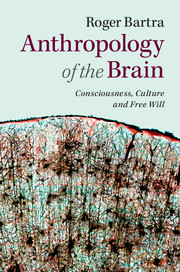Book contents
- Frontmatter
- Contents
- Preface
- Part I Consciousness and symbolic systems
- 1 The hypothesis
- 2 Evolution of the brain
- 3 Brain plasticity
- 4 Is there an internal language?
- 5 Amputations and supputations
- 6 The atrophied exocerebrum
- 7 The symbolic substitution system
- 8 Neuronal mirrors
- 9 Consciousness within hand’s reach
- 10 Outside and inside: the immense blue
- 11 The musical spheres of consciousness
- 12 Artificial memory
- 13 The lost soul
- Part II Brain and free will
- Bibliography
- Index
4 - Is there an internal language?
Published online by Cambridge University Press: 05 June 2014
- Frontmatter
- Contents
- Preface
- Part I Consciousness and symbolic systems
- 1 The hypothesis
- 2 Evolution of the brain
- 3 Brain plasticity
- 4 Is there an internal language?
- 5 Amputations and supputations
- 6 The atrophied exocerebrum
- 7 The symbolic substitution system
- 8 Neuronal mirrors
- 9 Consciousness within hand’s reach
- 10 Outside and inside: the immense blue
- 11 The musical spheres of consciousness
- 12 Artificial memory
- 13 The lost soul
- Part II Brain and free will
- Bibliography
- Index
Summary
An interpreting mechanism inside the brain that has the capacity to translate neuronal codes to cultural symbols (and vice versa) can be a very attractive idea. The best-known and most influential expression of this idea was formulated by Chomsky, who encouraged a search for the inborn neuronal circuits of a universal grammatical structure common to all humans. Many neuroscientists doubt the existence of such a linguistic structure in the nervous system. And if such mediating circuits do exist, they have yet to be found. This is a thorny problem, not only because of its intrinsic difficulty, but also because it has been contaminated by the old polemic about the relative weight of the cultural versus the natural in the configuration of consciousness. Language is obviously located in the neuronal space, as well as in the cultural dimension. Rather than polemicize about whether language is incorporated more in one of the two regions than the other, I believe it is necessary to study linguistic structures as a bridge joining the brain with culture. I do not think it is sufficient to prove that language and its context exert an important influence and that, thanks to plasticity, modify nerve circuits. Nor is it enough to establish that inborn neuronal circuits leave their mark on language structure and its social environment. I prefer instead to explore the possibility that language forms a part of exocerebral networks that, as such, are not exactly inside the brain, but are not an independent phenomenon disconnected from the nerve circuits either.
- Type
- Chapter
- Information
- Anthropology of the BrainConsciousness, Culture, and Free Will, pp. 21 - 26Publisher: Cambridge University PressPrint publication year: 2014



